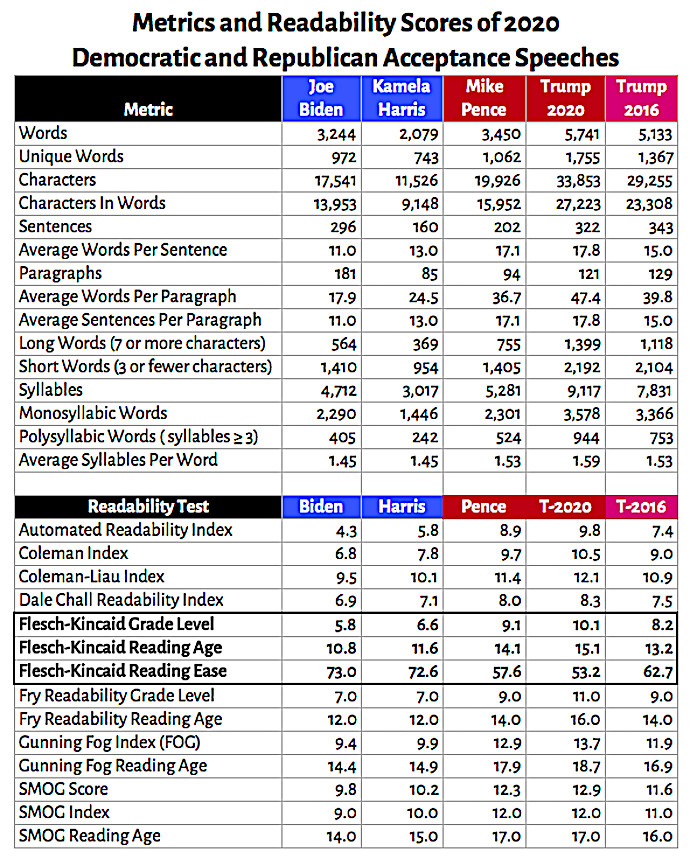4 September 2020 — 0525 mdt
Here are the metrics and Flesch-Kincaid readability scores for
the Biden, Harris, Trump, and Pence, acceptance speeches
Joe Biden’s rather brief acceptance speech may have been the most plainly and simply worded acceptance speech in American history — and that, reports Politico’s John Harris, was by design. More on that in a moment.
Donald Trump’s traditional get the crowd roaring acceptance speech was almost twice as long, and much more complexly worded — and that, too, was by design.
The readability scores and metrics of the speeches reveal how much the Democratic and Republican acceptance speeches differ:

Readability tests, scorned by many academics, have their limits. They measure neither eloquence, nor logic, nor truthfulness. But they do provide a measure of how well the complexity of the speech or essay matches up with the target audience’s ability to comprehend.
The best known readability tests are the Flesch-Kincaid grade level, reading age, and reading ease, tests that Peter Kincaid developed to assess the readability of manuals for the U.S. Navy. Rudolf Flesch, author of How to Write Plain English, developed his formulas in the early 1940s. The other readability scores in the table above are from some of the 40+ tests my WordCounter software performs. None is as useful as the Flesch-Kincaid tests, which built into most editions of Microsoft Word and other word processors. Flesh, a freeware Flesch-Kincaid calculator that runs on Java, can be downloaded from SourceForge.
Now, back to John Harris.
The Democratic Party’s convention managers decided to feature short, simply worded, speechs after studying how best to communicate in a virtual convention.
“We were trying to have a direct conversation with voters,” said Democratic consultant Stephanie Cutter, who took a lead role in staging the virtual convention. “There was no soaring oratory that would go down in the history books.”
This was the result, she said, of extensive research conducted on the different ways people respond when someone is speaking alone to a camera, rather than before an audience. As a general rule, they want simple language, delivered briefly, culminating not in a rhetorical flight but a specific call to action. Many speakers, she recalled, “thought we were insulting them” when told they had only a couple minutes to speak. “We said, “No, no—this is what you want.”
A direct conversation that seems to be with just one person is radio’s strength. Franklin D. Roosevelt’s fireside chats were masterpieces of political communication. His chats, more complexly worded (FK grade level, 11.3; reading ease, 56.4) than the 2020 Democratic Convention’s speeches, were clear and logical. FDR’s delivery provided the one-to-one coziness that kept the rapt attention of millions of Americans who gathered closely around the radio in their homes.
Like Roosevelt, Biden is a supremely accomplished orator, an expert at establishing the one-to-one intimacy required for radio and speaking directly into the television camera; a master of delivering inspiring stemwinders; a compassionate yet perceptive eulogist (watch his eulogy at Strom Thurmond’s funeral). There’s no mathematical formula for quantifying a speech’s upliftingness and warmth, but on a 0–10 scale, I give Biden a 20.
President Trump is not an accomplished orator. When sticking to a speech as written, his delivery flattens and starts becoming singsong. When ad libbing, he rants, roars, and comes close to foaming at the mouth, as he throws red meat to a roaring crowd that’s on its way to becoming a mob. He’s an accomplished demagogue. His acceptance speech’s Flesch-Kincaid scores are significantly higher than Biden’s. But while the content of Biden’s speech was uplifting, Trump’s was lowdown and depressing. There’s no mathematical formula for quantifying lowdown and depressing, but on a 10–0 scale, I give Trump a minus 10.
